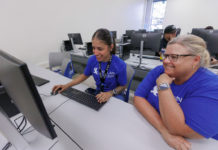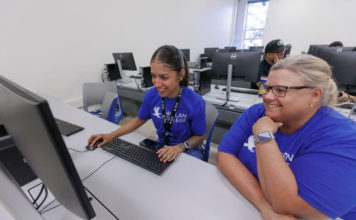GILROY
– It’s the time of year again when the birds are singing, the
bees are buzzing, but it’s not the spring season that is important
in the school district – it’s standardized testing season.
GILROY – It’s the time of year again when the birds are singing, the bees are buzzing, but it’s not the spring season that is important in the school district – it’s standardized testing season.
“We say, ‘The day has finally come,'” said Gilroy High School Principal Wendy Gudalewicz, adding that when the test scores arrive the stress will end.
“It’s the true measure,” she said about the test. “At least it is for the state.”
Tuesday the students of GHS will begin taking the Stanford Achievement Test, ninth edition, more commonly called the SAT-9. Given annually by the state for the last four years, all students in grades two through 11 are required to take the test.
“It’s a standardized test that measures the types of skills that a student should have at any particular grade level,” said Ester Corral–Carlson, Gilroy Unified School District director of student assessment. “When you are looking at the students’ progress, when you use a standardized test you can compare (them to other students).”
Because the GUSD operates on both year-round and traditional calendars, Rod Kelley Elementary School has already completed its standardized testing in two tracks, and Antonio Del Buono School will not begin testing until May 20.
This week all secondary schools, including South Valley and Brownell Junior High schools, will test, in addition to other alternative high school programs such as Mt. Madonna Continuation High School. Next week the schools will begin another phase of testing when they take the California Standards Tests.
According to Corral–Carlson, students should not spend more than 5 percent of their time in school testing, and the GUSD has students spending an average of 4 percent of class time testing, she said. In the GUSD, the window for testing begins when student have been in school for 136 days.
To prepare students for testing, high school staff have done “SAT-9 Mondays,” where teachers give students a review of SAT-9 material in the morning. The school has stepped up the practice for the last six weeks and the first 10 minutes of each period were spent reviewing material for the SAT-9, Gudalewicz said.
However, who can expect students to test well on an empty stomach? To make sure students are at their prime for test taking, free breakfast will be offered at the high school for all students from 7 to 7:50 a.m. – just in time for testing to begin at 8 a.m. Students spend the next two hours taking the SAT-9 tests.
Gudalewicz said she has also met with groups of students to discuss the importance of testing. In addition, students were told that they can be eligible for scholarships if they score within the top 10 percent for their grade level at their school, she said.
Students will not receive their scores until all testing is completed. Some schools will still be testing through the beginning of June. Test scores are expected to be reported by mid-July, Corral–Carlson said.
The state reports scores as a percentile rank. A group of about 250,000 students – called a “norming” group – from across the county are tested each year to determine what the average score for the test will be. Once the average score is determined, this score is set as the 50th percentile.
For example, if a student’s score in math is 61, it means the student is in the 61st percentile, and is 11 percentile points above the average of the 50th percentile. The percentiles are reported in a range of one through 99 percentile. Therefore, the student scored above 60 percent and below 38 percent of students who took the test in the “norming” group.
SAT-9 results are also used to calculate a school’s Academic Performance Index, the state’s annual growth target for schools. The state expects that schools will improve their standardized test scores five percent each year. The API index is from 200 to 1000, with all schools expected to reach the state’s target of 800.
Elementary schools will begin testing May 6. Last year, elementary schools had score gains with second grade scores increasing from the 47th percentile to the 60th percentile. Last year’s drops in scores were minimal, with the largest district wide decline reported in tenth grade social science scores of four percentile points.
The district has a goal to have 90 percent students performing at the 50th percentile by June 2004.
For more information on upcoming testing contact the GUSD at 847-2700.














